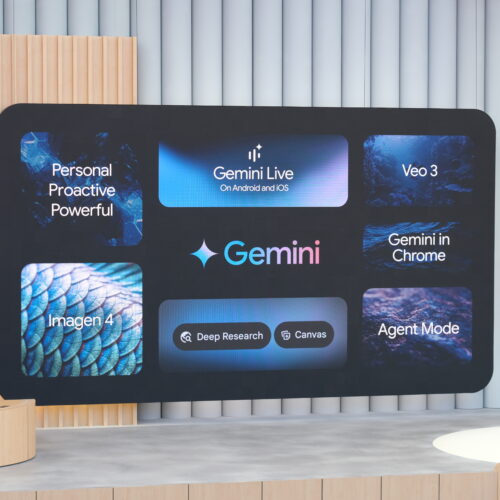The Time Sam Altman Asked for a Countersurveillance Audit of OpenAI


It’s Tuesday, May 20, 2025, and the funding firehose is wide open. We’re back with your daily rundown of the boldest bets and biggest checks fueling the future of tech. Today’s lineup features a wave of innovation across fintech, AI, […]
The post Top tech startup funding news for today, May 20, 2025 first appeared on Tech Startups.
The Microsoft Build 2025 conference in Seattle has entered its second day, and CEO Satya Nadella wasted no time in laying out what could be the company’s boldest vision yet: an open agentic web. In plain terms, Microsoft is betting […]
The post Microsoft Build 2025: All the big AI announcements you need to know first appeared on Tech Startups.

MOUNTAIN VIEW, Calif.—Google rolled out early versions of Gemini 2.5 earlier this year. Marking a significant improvement over the 2.0 branch. For the first time, Google's chatbot felt competitive with the likes of ChatGPT, but it's been "experimental" and later "preview" since then. At I/O 2025, Google announced general availability for Gemini 2.5, and these models will soon be integrated with Chrome. There's also a fancy new subscription plan to get the most from Google's AI. You probably won't like the pricing, though.
Even though Gemini 2.5 was revealed a few months ago, the older 2.0 Flash has been the default model all this time. Now that 2.5 is finally ready, the 2.5 Flash model will be swapped in as the new default. This model has built-in simulated reasoning, so its outputs are much more reliable than 2.0 Flash.
Google says the release version of 2.5 Flash is better at reasoning, coding, and multimodality, but it uses 20–30 percent fewer tokens than the preview version. This edition is now live in Vertex AI, AI Studio, and the Gemini app. It will be made the default model in early June.


© Ryan Whitwam
On May 6, OpenAI acquired AI coding startup WindSurf for $3 billion, its biggest deal yet. Less than two weeks later, Microsoft quietly open-sourced AI-native features in Visual Studio Code, making the core AI editor freely accessible and allowing forks […]
The post Did OpenAI just waste $3 billion on WindSurf, or could it have built the same using VS Code’s new open-source AI editor? first appeared on Tech Startups.


TrustCloud, a security assurance platform that leans heavily on AI to make life easier for enterprise security teams, just raised $15 million in strategic funding. The round was led by ServiceNow Ventures, with backing from Cisco Investments, Presidio Ventures, OpenView […]
The post TrustCloud raises $15M led by ServiceNow Ventures & Cisco to reinvent enterprise GRC with AI-driven risk automation first appeared on Tech Startups.



Google is constantly making changes to its search rankings, but not all updates are equal. Every few months, the company bundles up changes into a larger "core update." These updates make rapid and profound changes to search, so website operators watch them closely.
The March 2024 update was unique. It was one of Google's largest core updates ever, and it took over a month to fully roll out. Nothing has felt quite the same since. Whether the update was good or bad depends on who you ask—and maybe who you are.
It's common for websites to see traffic changes after a core update, but the impact of the March 2024 update marked a seismic shift. Google says the update aimed to address spam and AI-generated content in a meaningful way. Still, many publishers say they saw clicks on legitimate sites evaporate, while others have had to cope with unprecedented volatility in their traffic. Because Google owns almost the entire search market, changes in its algorithm can move the Internet itself.


© Aurich Lawson


In a major escalation of its push for tech sovereignty, Huawei just launched its first laptops running HarmonyOS—its homegrown operating system—officially severing ties with Western software giants Microsoft and Apple. The announcement marks a turning point in China’s quest to […]
The post China ends Windows–macOS duopoly with Huawei’s HarmonyOS, breaking U.S. tech grip first appeared on Tech Startups.
Quick Summary: Cursor: Best for experienced devs using VS Code who want advanced AI help with serious projects. Windsurf: Better for beginners, solo builders, or anyone who wants a lightweight AI IDE without setup. Bottom line: Cursor gives you control. […]
The post Windsurf vs Cursor: Which AI coding tool is better for your project (and why)? first appeared on Tech Startups.
The team behind Visual Studio Code shared a major update: VS Code is officially becoming an open-source AI editor. Microsoft is making the GitHub Copilot Chat extension open source and bringing AI features directly into the core editor, all under […]
The post Microsoft makes Visual Studio Code (VS Code) an open source AI editor, ushering in a new era of developer tools first appeared on Tech Startups.
For years, domain investing was fueled by one major force: startups. As new companies launched, so did the demand for premium .coms and brandable domains. But in 2025, that engine is stalling—and domain sales are crashing. Across the industry, domain […]
The post Why domain sales are crashing in 2025: How AI and a shift in search behavior are reshaping the domain market first appeared on Tech Startups.

New Orleans police have reportedly spent years scanning live feeds of city streets and secretly using facial recognition to identify suspects in real time—in seeming defiance of a city ordinance designed to prevent false arrests and protect citizens' civil rights.
A Washington Post investigation uncovered the dodgy practice, which relied on a private network of more than 200 cameras to automatically ping cops' phones when a possible match for a suspect was detected. Court records and public data suggest that these cameras "played a role in dozens of arrests," the Post found, but most uses were never disclosed in police reports.
That seems like a problem, the Post reported, since a 2022 city council ordinance required much more oversight for the tech. Rather than instantly detaining supposed suspects the second they pop up on live feeds, cops were only supposed to use the tech to find "specific suspects in their investigations of violent crimes," the Post reported. And in those limited cases, the cops were supposed to send images to a "fusion center," where at least two examiners "trained in identifying faces" using AI software had to agree on alleged matches before cops approached suspects.


© ANDREY DENISYUK | Moment